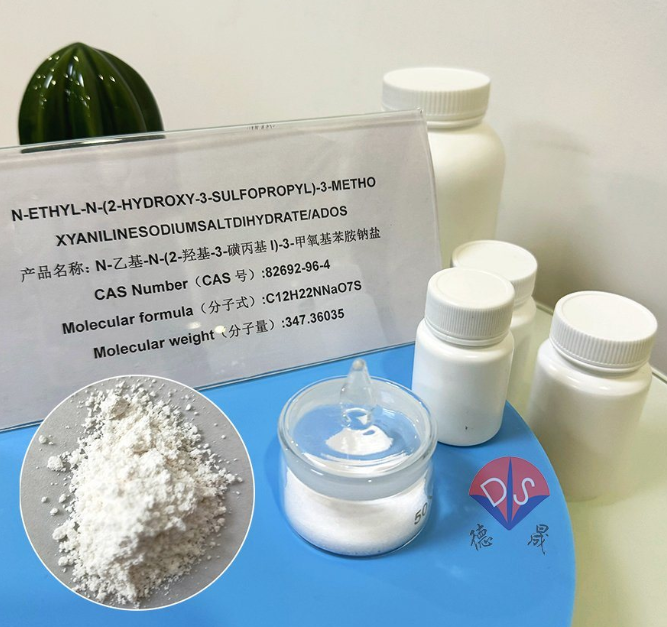-
 Doris Yang
Hi there! Welcome to my shop. Let me know if you have any questions.
Doris Yang
Hi there! Welcome to my shop. Let me know if you have any questions.
Your message has exceeded the limit.

Stability and storage conditions of ADOS products as chromogenic substrates
2025-08-27 15:06:35
As a core reagent in enzyme-linked immunosorbent assay (ELISA) and colorimetric analysis, the stability of the chromogenic substrate N-ethyl-N - (2-hydroxy-3-sulfopropyl) -3-methoxyaniline sodium salt (ADOS) directly determines the reliability of the detection results. This active molecule is highly susceptible to environmental interference, and if stored improperly, it may lead to a decrease in colorimetric efficiency, an increase in background noise, and even changes in reaction specificity. This article will systematically explain the scientific storage plan for ADOS products from two dimensions: stability influencing factors and preservation strategies.
Stability influencing factors: cracking ADOS' fragile password '
1.1 The "double-edged sword" effect of temperature: The sulfonic acid group in ADOS molecules forms a conjugated system with the methoxybenzene ring. High temperature accelerates the thermal motion of the molecule, disrupting the balance between hydrogen bonding and hydrophobic interactions. When the temperature exceeds 25 ℃, its chromophore may undergo irreversible conformational changes, leading to a decrease in its ability to bind to the enzyme; Long term freezing (below -20 ℃) may cause molecular crystallization and affect solubility.
1.2 The essence of the "invisible killer" of light is that the benzene ring structure of ADOS has strong absorption in the UV visible region, and the light will excite electron transitions to produce free radicals, triggering a chain oxidation reaction. Experimental observations show that the color intensity of samples stored without light protection can decay by up to 40% after 30 days, accompanied by the generation of yellow by-products.
1.3 The "chronic erosion" process of 1.3 humidity, as ADOS exists in the form of sodium salt, has strong hygroscopicity and is prone to deliquescence and agglomeration when the relative humidity exceeds 60%. Humidity not only changes the physical form of reagents, but also disrupts their molecular structure through hydrolysis, leading to the degradation of active ingredients.
1.4 The precise regulation of pH value requires that the ionization state of sulfonic acid groups in ADOS is highly dependent on the environmental pH value, and the neutral range (pH 6.5-7.5) is the window for its optimal activity. PH deviation can cause changes in molecular charge distribution, affecting its binding affinity with proteins.
The method of saving ADOS
1. The storage of ADOS products requires the establishment of a comprehensive protection system: temperature management is a key link, and short-term storage should be placed in a cool and dark place to avoid severe temperature fluctuations; Long term storage requires a low-temperature environment, combined with vacuum sealed packaging and desiccant protection to prevent activity loss due to temperature cycling.
2. Light protection should be implemented throughout the entire process, and reagents should be packaged in dark, light resistant materials to prevent molecular degradation caused by natural light and strong light exposure.
3. Humidity control needs to be implemented in stages. Unopened reagents need to be stored in a dry environment, and internal humidity stability should be maintained through moisture-proof cabinets or desiccants during use. Long term storage requires the use of professional humidity control equipment to prevent moisture absorption and agglomeration from affecting solubility.
4. The integrity of the packaging needs to be strictly maintained. After opening, it should be promptly packaged in a sealed container, and multiple sealing measures should be taken to isolate the external environment. Non powder gloves should be worn during operation to avoid hand contamination and reagent deterioration.
Hubei Xindesheng Material Technology Co., Ltd. specializes in the research and production of ADOS and other color developing substrate reagent powder raw materials. The products have high purity, good water solubility, sensitive reaction, stable production process, small batch differences, and affordable prices. Professional researchers and technical teams provide customized services and guarantee after-sales service. We have established cooperation with many domestic and foreign enterprises. If you have any purchasing needs in the near future, please click on the official website for more details or contact me!
Tags: ADOS, chromogenic substrates, 82692-96-4
Popular Searches
- sodium hypochlorite
- naclo
- hypochlorite
- calcium hypochlorite
- calcium salt
- potassium butyl xanthate
- calcium sodium
- sodium hypochlorite production
- sodium process
- granule sodium
- sodium hypochlorite water
- sodium 80% powder
- lime plastering
- sodium hypochlorite disinfection
- hypochlorite sodium
- sodium granular powder

